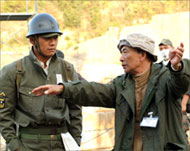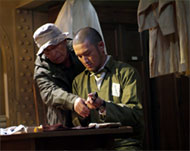Battleship Yamato resurfaces on screen
Sixty years after it was sunk, the Imperial Japanese Navy battleship Yamato is about to recreate her final journey -in cinema screens across Japan.

And while the producer’s target of 10 million viewers for the film is ambitious, an even harder task might be in convincing moviegoers in the rest of Asia that it is not a work of implicit nationalism.
“I want this to be more than just a successful film,” said Haruki Kadokawa, producer of Yamato: The Last Battle.
“I want people to have more pride in Japan and a sense of responsibility.”
According to Yoko Ota, spokeswoman for Toei, the company behind the film, an estimated 135,000 people went to see the movie on its opening day last week. A similar number attended screenings on Sunday.
“We are very happy with these figures and they are better than we expected,” she said. “We hope it continues to be popular.”
Kamikaze action
The largest battleship in the world when she cast off from the docks at Tokuyama, southern Japan, on 6 April 1945, the Yamato had been an icon for the nation when its empire stretched from New Guinea to the Russian frontier.
|
“I was born in an age of peace in Japan and before the film I had never really thought about the fact that the peace I enjoy today is built on the sacrifices of others and that my appreciation of that was not as deep as it should have been” Actor Kenichi Matsuyama, 20, who plays an anti-aircraft gunner |
In the last months of the second world war, however, the increasingly desperate Japanese leadership preferred suicide charges to surrender and pressed the pride of its fleet into the most spectacular of kamikaze raids.
Weighing in at 72,800 tonnes and able to bring nine 40-cm guns to bear, the Yamato set sail against the US invasion fleet off Okinawa.
Allied radio intercepts and code-breakers gave advance warning of her approach and the Yamato was attacked by an estimated 350 US aircraft off southern Kyushu.
It took 22 hours to turn the most powerful warship of its era into a smoking hulk that eventually sank with the loss of more than 3000 of her crew.
Kadokawa, who pumped $25 million of his own money into the project after other potential backers turned him down, said the film was intended for audiences at home and overseas.
“When we were making it we kept very much in mind the idea that we were not just making a domestic film, but an international film.
“I still hope that will be the case, but I realise that the way people will react to the film will differ between countries.
“I feel very strongly that the anti-Japanese demonstrators were acting without knowing about Japan and it was the result of government propaganda.
“I hope very much that when people in China and South Korea see the movie they will begin to truly understand Japanese culture.”
Japan’s relations with China and South Korea have been at a low ebb in recent months, largely over what its neighbours see as Tokyo’s downplaying of its war-time atrocities.
Survivor’s story
On 31 April 1985, Japanese researchers located the Yamato 350m below water in the Pacific Ocean.
 |
|
Director Junya Sato (R), on the |
Mutsuru Uchida, one of only 267 survivors, was interviewed as part of a book about the loss of the warship and took part in a ceremony for the spirits of his dead comrades above the site of the wreck.
It was after meeting Uchida that Kadokawa was first inspired by the story of the Yamato.
When Uchida died in 2002, he asked in his will that his ashes be scattered above the spot where so many of his shipmates had died.
“I was very moved by his final message to his family -‘Thank you so very much for enabling me to live for so long’ -that I resolved to make this film,” said Kadokawa.
Budget
About ¥600 million ($5.5 million) was spent on the construction of a two-thirds size replica of the Yamato at a shipyard in Hiroshima Prefecture, southern Japan.
That figure is usually the total cost of a Japanese movie.
The vast bridge of the ship was recreated, as well as gun turrets and the towering bow, complete with the Imperial chrysanthemum crest that the original carried.
 |
|
The film’s backers say it is not a |
Discussions have been held with the local city government about leaving the set intact and turning it into a tourist attraction.
Japan’s Maritime Self-Defence Forces also cooperated with the making of the movie, their vessels being used to create real bow-waves – the waves that pile up in front of a ship – although the producer was keen to emphasise that no money was paid to the SDF.
“I had been very impressed with Titanic and the way it used film combined with computer-generated images, so I decided to create a set that would bring the ship to life again,” said Kadokawa.
History’s lessons
The 26 remaining survivors were consulted throughout the making of the film, said Kadokawa. “They watched the battle scenes and were very impressed,” he said. “Some of them were moved to tears but also great joy.”
Junya Sato, the director of the film, was also keen to emphasise that while audiences in different countries will inevitably see the movie through different perspectives of history, he had three main points that he wanted to get across.
“Firstly to focus on the thinking of the time and show that those who take power through force will lose it in the same way.
|
“All of us who worked on the film had as our fundamental view that we never again wanted to experience war. I think that message was very clear” Haruki Kadokawa, producer |
“Secondly that these were young and innocent people sent to their deaths and that it is clear those who bore the responsibility for that were the political leaders.
“Thirdly, I wanted to look at the current state of Japan and what we must do to make it better.”
Actor Kenichi Matsuyama, 20, who plays an anti-aircraft gunner, said making the film has made him understand how fortunate he is to have grown up in a country that is at peace.
“I was born in an age of peace in Japan and before the film I had never really thought about the fact that the peace I enjoy today is built on the sacrifices of others and that my appreciation of that was not as deep as it should have been.”
But not all Japanese believes the film is a harmless anti-war tale that conveniently coincides with the anniversary of Imperial Japan’s final defeat.
Tsuyoshi Amemiya, a retired professor of military history at Aoyama Gakuin University, said: “Japan is becoming more nationalistic, militaristic and right-wing -and the production of this movie is just another part of that.”
But producer Kadokawa was adamant that the film did not glorify war.
“All of us who worked on the film had as our fundamental view that we never again wanted to experience war. I think that message was very clear.”
Pictures courtesy of Toei Company